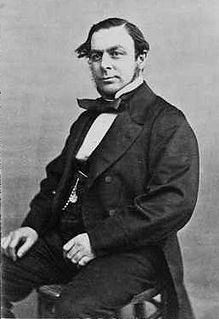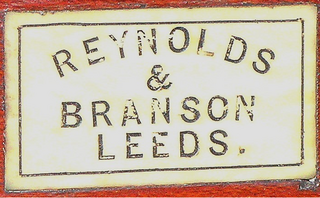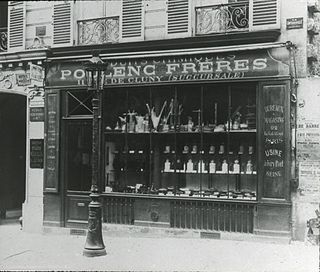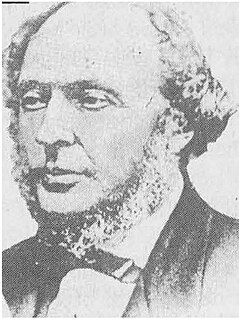Related Research Articles

Sir Richard Atkinson Robinson, DL, was a retail chemist and druggist, who later became a local politician and was the first member of the Municipal Reform Party to lead the London County Council (1907–1908).

Eli Lilly was an American soldier, pharmacist, chemist, and businessman who founded the Eli Lilly and Company pharmaceutical corporation. Lilly enlisted in the Union Army during the American Civil War and recruited a company of men to serve with him in the 18th Independent Battery Indiana Light Artillery. He was later promoted to major and then colonel, and was given command of the 9th Regiment Indiana Cavalry. Lilly was captured in September 1864 and held as a prisoner of war until January 1865. After the war, he attempted to run a plantation in Mississippi, but it failed and he returned to his pharmacy profession after the death of his first wife. Lilly remarried and worked with business partners in several pharmacies in Indiana and Illinois before opening his own business in 1876 in Indianapolis. Lilly's company manufactured drugs and marketed them on a wholesale basis to pharmacies. Lilly's pharmaceutical firm proved to be successful and he soon became wealthy after making numerous advances in medicinal drug manufacturing. Two of the early advances he pioneered were creating gelatin capsules to contain medicines and developing fruit flavorings. Eli Lilly and Company became one of the first pharmaceutical firms of its kind to staff a dedicated research department and put into place numerous quality-assurance measures.

Hensoldt UK, formerly Kelvin Hughes, is a British company specialising in the design and manufacture of navigation and surveillance systems and a supplier of navigational data to both the commercial marine and government marketplace.

Massachusetts College of Pharmacy and Health Sciences (MCPHS) is a private university focused on medical and health-related science programs and located in the Longwood Medical and Academic Area of Boston, Massachusetts. The university provides traditional and accelerated programs of study focused on professional education in pharmacy and the health sciences. Since 2000, MCPHS University has expanded to include two additional campuses, located in Worcester, Massachusetts, and Manchester, New Hampshire.
A. M. Bickford and Sons was one of the first manufacturing chemists in South Australia and until 1930 one of the State's most significant family owned companies. In 1930, they amalgamated with half a dozen other similar Australian companies to form "Drug Houses of Australia" (DHA), which very successfully continued to produce the "A. M. Bickford and Sons" products: the "drugs" and "chemicals" under the DHA brand; the cordials and soft drinks under the "A. M. Bickford and Sons" brand.

Kempthorne Prosser & Co. Ltd, also known as the New Zealand Drug Company Ltd, was the leading drug and fertiliser manufacturer in New Zealand from 1869 until 1978. Their full name was Kempthorne Prosser & Co.'s New Zealand Drug Co. Ltd, established in Dunedin.
Timothy Whites was a British chain of dispensing chemist and houseware stores.

Taylor, Lang & Co. was a textile machinery manufacturer based in Stalybridge, Greater Manchester, England.

F. H. Faulding & Co was a pharmaceutical company founded in Adelaide, Australia, in 1845 by Francis Hardey Faulding, a native of Swinefleet, near Goole in Yorkshire, son of Francis Faulding, a surgeon.

MacFarlan Smith is a pharmaceutical research company based in Edinburgh, Scotland, founded in 1815. It is part of the Fine Chemical and Catalysts division of Johnson Matthey.

AAH is a pharmaceutical wholesaler in the United Kingdom. Originally formed in 1892 as a company selling solid fuels in South Wales, it was floated on the stock exchange in 1923. It diversified into pharmaceuticals in the 1970s, and since 1995 it has been a subsidiary of the German company Celesio AG.
Charles Frederick Thackray (1877-1934) was a pharmacist and manufacturer of surgical instruments in Leeds.
Richard Haworth and Co. was established by Richard Haworth in 1854 as a cotton spinning and manufacturing firm in Cannon Street, Manchester, and Tatton Mill in Salford. Today the company is part of the Ruia Group which comprises a number of companies that import, supply and distribute textiles and hosiery to retailers and hospitality organisations. Richard Haworth Ltd. supplies a range of linens to the hospitality sector.
Samuel Barbour was an Australian chemist, photographer and X-ray pioneer in the colony of South Australia. In Australia, the medical men of the day took a slow approach in the adoption of the new science that involved X-rays. Many of the early demonstrations were made by investigators outside the medical field. Upon examination of the initial investigators, several key factors were common. The individuals had already either been experimenting along similar lines to Wilhelm Röntgen with Crookes tubes and such, the physicists or scientists, or were actively associated with electrical work, the electricians, which made them particularly receptive to the technical appeal of the new science of X-rays. Records of the events reveal that among the medical men who witnessed the first images produced as radiographs, a rather small number had any great desire to employ X-rays directly in their own medical practice.

Reynolds & Branson Leeds was a business based at 13 Briggate and 14 Commercial Street in Leeds, England. The business lasted from 1816 to 1972. Edward Matterson managed the company in 1822, and William West F.R.S. took over in 1833. The National Archives Records about the company include a day book, sales ledger, and prescription books. The records were created by Reynolds & Branson Ltd. Reynolds & Branson was registered in July 1898 as a limited corporation with a capital of £34,000 in shares of £10 each by Messrs. R. Reynolds, F. W. Branson. No remuneration was given to Mr. R. Reynolds, but a £700 per annum was given to each of the others. In 1890, Richard Reynold's son, Richard Freshfield (Fred) Reynolds was made a partner. The firm was in the business of wholesale and retail for chemists and surgical instrument makers.
Richard Reynolds, FCS, was an English pharmaceutical chemist, optician, instrument maker, and X-ray pioneer.
Frederick Woodward Branson, FIC, FCS was a British chemist, glassblower, instrument maker and X-ray pioneer.

Poulenc Frères was a French chemical, pharmaceutical and photographic supplies company that had its origins in a Paris pharmacy founded in 1827. From 1852 it began to manufacture photographic chemicals. It took the name Poulenc Frères in 1881, and by 1900 had a range of high-quality products. That year it went public as the Établissements Poulenc Frères. It began production of synthetic medicines, and continued to grow during World War I (1914–18). In 1928 it merged with the Société des usines chimiques du Rhône to form Rhône-Poulenc.
Florence Anne Boot, Lady Trent (1863–1952) was a Jersey businesswoman and philanthropist. She assisted her husband, Jesse Boot, in running Boots chemists after their marriage in 1886. Florence was responsible for diversifying the firm's retail offering to include perfume, cosmetics, stationery, books, and other general merchandise and also pioneered in-store cafés. Florence promoted employee welfare, establishing an athletics club and a school to continue the education of Boots' younger employees. She also made significant donations of land for public use in Jersey and founded the first all-female hall of residence at the University of Nottingham.

William Flockhart, L.R.C.S.E. was a Scottish chemist, a pharmacist who provided chloroform to Doctor James Young Simpson for his anaesthesia experiment at 52 Queen Street, Edinburgh on 4 November 1847. This was the first use of this chemical on humans when Simpson tried it on himself and a few friends, and then used it for pain relief in obstetrics, and surgery. This changed medical practice for over a century, according to the British Medical Journal.
References
- ↑ Jones, RW (22 January 2003). "Dalton's unfortunate choice". Notes and Records. Royal Society. Retrieved 15 May 2017.
- ↑ "James Woolley, Sons and Co. Ltd Archive". The University of Manchester Library. University of Manchester. Retrieved 15 May 2017.
- ↑ "James Woolley, Sons & Co. Ltd. Company History". Historic Camera. Retrieved 15 May 2017.
- ↑ Wooleys of Manchester. Manchester: James Woolley, Sons & Co Ltd. 1947.
- ↑ "Opening of the Woolley Laboratories". Pharmaceutical Journal. 1 November 1930. Retrieved 15 May 2017.
- ↑ "James Woolley, Sons and Co". Graces Guide to British Industrial History. Retrieved 15 May 2017.